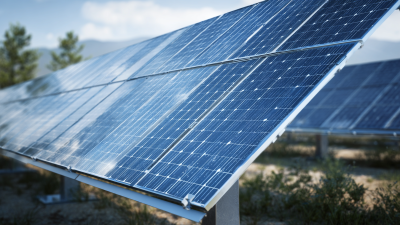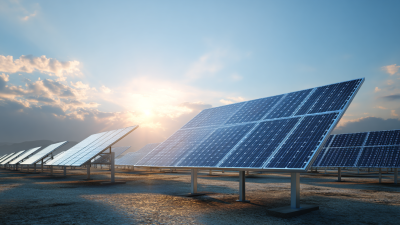Ultimate Guide to Harnessing Solar Thermal Energy for Your Home
As the world increasingly shifts towards renewable energy solutions, solar thermal technology stands out as a promising option for homeowners seeking sustainable and cost-effective energy sources. According to the International Renewable Energy Agency (IRENA), solar thermal energy has the potential to meet up to 13% of global heating demands by 2030. This versatile technology harnesses the sun's heat for various applications, including water heating, space heating, and even electricity generation. With advancements in solar thermal systems making them more efficient and accessible, there has never been a better time for homeowners to explore their benefits. In this ultimate guide, we will delve into how solar thermal systems work, their advantages, practical installation examples, and how you can take advantage of this renewable energy source to reduce your carbon footprint while potentially lowering your energy bills.

Understanding Solar Thermal Energy: What It Is and How It Works
Solar thermal energy harnesses the sun’s heat to produce energy, providing an efficient alternative to conventional heating methods. Unlike solar photovoltaic systems that convert sunlight into electricity, solar thermal systems capture and use heat directly for applications such as space heating, hot water supply, and even cooling. According to a report from the International Renewable Energy Agency (IRENA), solar thermal technologies have the potential to meet up to 90% of the hot water demands in residential settings, significantly reducing reliance on fossil fuels.
The technology behind solar thermal energy involves collectors that absorb sunlight and convert it into heat. These collectors can be either flat-plate or evacuated tube types, with the latter typically offering higher efficiency in cooler climates. The heated fluid circulates through a system, transferring energy for use in heating water or spaces within the home. As per the U.S. Department of Energy, households can save anywhere between 20% to 50% on their energy bills by integrating solar thermal systems. With increasing installations and advancements in technology, the solar thermal market is expected to grow, contributing further to the shift toward renewable energy sources.

Top Benefits of Installing Solar Thermal Systems in Your Home
Installing solar thermal systems in your home brings a multitude of benefits that can enhance both your comfort and energy efficiency. One of the primary advantages is the significant reduction in energy bills. Solar thermal energy captures sunlight to heat water, providing a renewable source for domestic hot water needs and heating systems. By utilizing this sustainable energy, homeowners can minimize their reliance on conventional energy sources, leading to cost savings in the long run.
Another considerable benefit is the positive environmental impact. By opting for solar thermal systems, homeowners contribute to reducing carbon emissions and the overall carbon footprint. This shift towards renewable energy helps combat climate change, supporting a sustainable future for generations to come. Additionally, many regions offer incentives such as tax credits or rebates for installing solar technologies, making the transition to solar thermal systems not only an eco-friendly choice but also a financially savvy one. Embracing this technology empowers homeowners to make a responsible choice that benefits both their wallets and the planet.
Choosing the Right Solar Thermal System: A Comprehensive Comparison
When it comes to selecting the right solar thermal system for your home, it's essential to navigate through various options available in the market. According to a report by the U.S. Department of Energy (DOE), solar thermal systems can reduce water heating bills by up to 50% annually, making them an attractive investment for homeowners seeking sustainable energy solutions. Two primary types dominate the market: flat-plate collectors and evacuated tube collectors. Flat-plate systems are typically more affordable and easier to install, while evacuated tubes provide superior efficiency, particularly in colder climates.
Furthermore, understanding the energy requirements of your household can guide your choice of system size and type. The Solar Energy Industries Association (SEIA) suggests that assessing your current energy consumption can significantly impact your return on investment (ROI). For instance, a typical family home may require a solar thermal system capable of producing around 60 gallons of hot water daily, translating to an investment of approximately $5,000 to $8,000 for flat-plate systems. In contrast, evacuated tube systems may initially cost more, but their efficiency can lead to higher savings in the long run, especially when paired with rebates and incentives.
Key Factors to Consider for Maximum Efficiency in Solar Thermal Energy
The efficiency of solar thermal energy systems can be significantly influenced by several key factors, optimizing their performance for residential applications. First and foremost, the design and orientation of solar collectors directly impact their energy absorption potential. Research indicates that systems set at a tilt angle of about 30 degrees toward the sun can increase heat absorption by approximately 15% compared to flat installations. Additionally, incorporating high-performance thermal materials, such as selective coatings, can further enhance heat retention and minimize thermal losses, improving overall system efficiency.
Another critical aspect to consider is the integration of smart controls and storage solutions. A study by the National Renewable Energy Laboratory (NREL) indicates that advanced thermal energy storage systems can boost the usability of solar thermal energy by up to 40%, enabling homeowners to access heat when solar generation is low. Furthermore, regular maintenance and optimization of fluid circulation within the system are essential to ensure maximum heat transfer efficiency. By addressing these factors, homeowners can not only enjoy reduced energy bills but also contribute to broader sustainability goals by making the most of renewable energy resources.
Maintenance Tips to Ensure Longevity and Performance of Your Solar Thermal System
To ensure the longevity and performance of your solar thermal system, regular maintenance is key. Start by inspecting the collector panels regularly for any debris, dirt, or snow accumulation that could impede their efficiency. A simple rinse with water can often restore their optimal function. Furthermore, check for any signs of wear on the pipes and connections, as leaks can significantly affect system performance. It’s advisable to clean the panels at least once a season, or more frequently if your region experiences heavy dust or pollen.

Another critical aspect of maintenance involves monitoring the system's performance. Keep an eye on temperature gauges and pressure readings to identify any anomalies. If you notice significant drops in efficiency or irregularities in the readings, it may be time to consult a professional for a thorough inspection. Additionally, ensure that the expansion tank, if present, is functioning correctly to prevent pressure build-up, which can damage the system. Regular checks and professional servicing will not only enhance the reliability of your solar thermal system but also extend its life, ensuring you reap the full benefits of renewable energy in your home.



